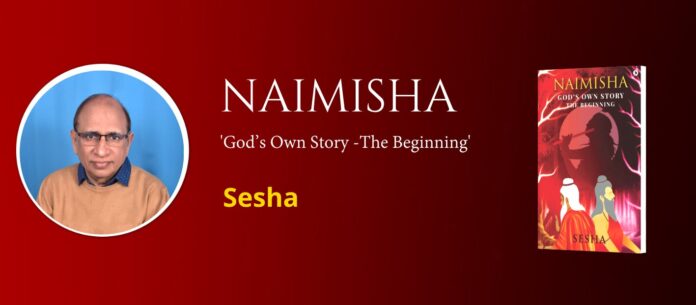About the Author: Author Sesha is deeply interested in the subject of epics ever since he was exposed to them in childhood. He was a postgraduate in Commerce and Management and stood first in the university both at graduation and Master’s levels. A prolific reader and an active participant in the forum Quora having placed 3.4K questions and giving 6.6K answers in the past 6.5 years and has about 1000 plus followers. He had put in 40-plus years of service in a nationalized bank as an executive before retiring in the top management cadre. That is when he reconnected with his hobbies of youth and his passion to retell Srimad Bhagavatam and Mahabharata in one book propelled this project.
He dropped in a few fictional characters into Pre-Mahabharata times as if they lived along with those mythological characters and narrated the story watching the epics unfold even before Vyasa penned them later. The book also deals with the classic dilemma of belief versus proof in accepting miracles and Godhood through the trial of Animish and Asareer.
Q1: Why did you write this book? There are many mythological fictions in the market, distorting the original epics, and why did you want to add one more?
Answer: I have no comment on any of the current mythological fiction books, many of which I refrained from reading in the last five years for the fear of getting impressed or influenced by them. Some may be good, some may be bad. That is decided by how the readers take them. Now, I am going to read them all; I already started.
Once you know the original story and then read the fiction the so-called distortion is the author’s artistic imagination. You can appreciate the author’s viewpoint as to why he/she has deviated from the original. Some deviations enhance the beauty of narration like Kalidasa’s Abhijnana Saakuntalm or the works of Bhasa like Pancharatram and others. However, I agree that all work that deviates can neither prove a point nor provide artistic pleasure to the reader.
As far as I am concerned, I think I have a different narrative style to retell the story not told by any so far and I ventured to put it on record.
Q2: What could be new in retelling mythology unless you are going to change the plot, incidents, characters, and events to tell whatever you wanted to tell? Certainly, you can’t stick to the original and if you are writing the original, why anybody would have to read yours instead of the original?
Answer: That is certainly a pertinent question though it is too long. I have kept the storyline almost intact. However, the story is not only the story as told by Veda Vyasa. The incidents are interpreted by the characters in their own way as they understood and that should prove interesting. As far as my fictional characters are concerned, they have all the freedom to say what they want to say and feel whatever they want to feel. That adds an unknown angle to the known story to make it interesting. The idea is to present the original without much distortion but in a different way to make it interesting.
Q3:What exactly motivated you to start this mammoth project, combining two big epics and superimposing fiction?
Answer: The motivation came the moment I realized that Krishna’s story was told in two epics separately and so far none, to my knowledge, attempted to combine them, that too in a modern retelling. This looked like an opportunity left open for me. In fact, I thought it would not be so big as Krishna’s story starts only in Dasama Skanda in Bhagavatam and then I can straight come to Mahabharata and end with his parting the world. That would have been easier for me and a soft read for readers as well. However, while collecting the data, I saw so many stories and connections which I didn’t observe earlier and I am fascinated by war parvas and started adding them which was not in my original plan. Thus the urge to cover more expanded the story. I have the complete script for the second book, but I am editing it right now.
Q4:What is the message you want to give to your readers through this book?
Answer: The message is in-built into the story of Mahabharata. ‘You protect Dharma and Dharma protects you.’ Those who follow the story would obviously realize that message. However, as a fictional narrative, the first part raises certain questions to be answered later. Readers would get the full purport after reading the rest of the story. The focus is not on any separate message but the real intention is to make the readers know these two epics more than what they presently know.
The idea is to kindle interest in the readers to refer to original epics.
Q5:What can be expected in the second part?
Answer: The first part stopped after Karna was introduced, and befriended Duryodhana publicly. The next part will cover the Gurudakshina war, Murder attempts on Pandavas, Draupadi Swayamvaram, Rajasuya, Dice game, etc., etc., A lot of story needs to be covered. It would certainly be more interesting than the first as this contains the most interesting and controversial incidents.
Here’s the Amazon Book Link: Naimisha: God’s Own Story – The Beginning https://amzn.eu/d/iQFrCoP


